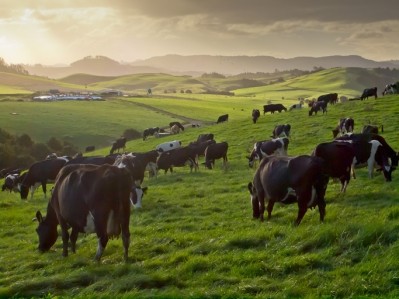US: Novel wheatgrass provides perennial forage, grain

New agricultural systems are needed to protect the environment and address areas like soil conservation, carbon sequestration and water quality, said Valentin Picasso, assistant professor in agronomy at the University of Wisconsin-Madison.
Conventional crops such as corn, and soybeans, and wheat, and rice are annuals, they are very productive, and produce calories for food and animal feed, but they come at the cost of soil erosion and consequently water quality problems while releasing a lot of carbon into the environment, he told us.
Perennial crops would, such as Kernza intermediate wheatgrass, represent an effective alternative to improve the sustainability of the current agricultural system, said Picasso.
Picasso and other researchers at the University of Wisconsin-Madison have been exploring the nutritional potential of Kernza intermediate wheatgrass, as a livestock feed.
Their work was published in the journal Animal Feed Science and Technology.
The nutritional assessment sought to characterize the forage nutritive value along with fiber digestibility of Kernza intermediate wheatgrass when it raised in a dual-use system, Picasso said. The nutritional quality was checked three times – during initial growth in the spring, following the harvest of grain in the summer and after regrowth in the autumn.
“The main point of the paper is trying to assess what is the forage quality, the nutritive value of this crop,” he said.
Dual-use production is when a crop is raised for both forage and grain, added Picasso. “You can harvest grain and you can harvest forage, so it’s a system that really is reintegrating crop production and livestock production.”
The researchers found that the forage generated in both the spring and fall/autumn could be used with growing or lactating cattle. The residue crop following grain harvest in the summer could be used as part of a mixed ration for dry cows.
Developing a grain-producing perennial forage
Kernza intermediate wheatgrass was conventionally bred from forage wheatgrass to improve the amount of grain generated, said Picasso.
“It’s really the most innovative thing that is happening in the agriculture business right now,” he said. “To try to solve the… environmental problems and at the same time profitability of the livestock and dairy industry.”
The crop may also be of interest to organic producers because it was conventionally developed, he said. And no herbicides or pesticides have been approved for use with the grain crop produced.
The plant crop may have some interest for integrated producers as it can be both grazed can and produce grain, he said.
The plant continues to regenerate without needing to be replanted, he said. “Once you plant it, it can last forever – we’ve seen twenty, thirty-year stands,” he added.
However, the grain yield declines over time, he said. Research into management practices to improve long-term grain yields is ongoing.
Research process and results
In the nutritional assessment, plots of the perennial forage and grain crop were grown in a monoculture system and in a mixture with red clover, the researchers said. Forage samples were collected in the spring, in the summer along with the grain harvest and in the autumn following a re-growth period.
The crop is planted in the fall like winter wheat, said Picasso. The forage can then be harvested or grazed in the spring and autumn and a grain hay crop can be collected in August.
“This is a very tall grass – up to five feet in some cases – so after you harvest the grain you still have two or three feet of forage biomass that is somewhat like wheat straw, but there’s still a lot of green leaves because it is perennial, so it’s better quality,” he said. “You harvest that or bale it and you can use it for feeding and then it regrows.”
The nutritional value of the monoculture was highest in the spring, followed by the fall than summer, the researchers said. The spring harvest generated 456, 249 and 225g kg-1 of neutral detergent fiber (NDF), acid detergent fiber (ADF) and crude protein (CP), respectively.
The relative forage quality (RFQ) for Kernza was 175 for spring forage, 116 for autumn forage and 65 for summer residue, they said. When the plant was co-cropped with red clover, the crude protein level of summer crop residue improved 69% and fall forage saw a 49% boost to crude protein and an 11% increase in RFQ as both NDF and ADF declined.
“We assessed the forage quality of the spring material, of the summer material and the fall material. The spring and fall material is really good quality, as we expected,” he said. “The summer material is low quality overall, but it’s better than wheat straw and some other feedstuffs.”
The main surprise from the findings was that the crop was able to out-compete annual weeds that were present in the test plots, said Picasso.
Feeding implications and ongoing research
The nutritional assessment found that Kernza intermediate wheatgrass forage has a nutritional value similar to cool-season grasses, the researchers said. That makes it suitable for use in diets for lactating beef and dairy cows and growing heifers.
Crop residue following grain harvest could be used with dry cows as part of a mixed ration, they said.
Along with checking the nutritional value of the forage, feeding trials using the plant are starting to take place, said Picasso.
The research team ran a follow-up study comparing the use of an alfalfa hay diet with a 50% alfalfa and 50% Kernza hay from the summer cutting in feeds for pregnant beef cows, he said.
“In both cases, the pregnant cows over the winter gained weight and improved body condition,” he said. “We think at least 50% or probably more could be used in a ration to feed cattle.”
The research continues, using higher levels of the Kernza straw, he added.
The group is also in the process of writing up a grazing study that assessed the use of autumn and spring Kernza forage, Picasso said. Results so far indicate that grazing the forage does not reduce summer grain production and may improve it.
Source: Animal Feed Science and Technology
DOI: doi.org/10.1016/j.anifeedsci.2019.114298
Title: Forage nutritive value and predicted fiber digestibility of Kernza intermediate wheatgrass in monoculture and in mixture with red clover during the first production year
Authors: J.R. Favre, T.M. Castiblanco, D.K. Combs, M.A. Wattiaux, V.D. Picasso












